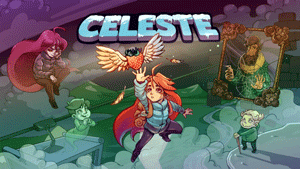Game Review: Celeste

Oftentimes in life, people face hardships, whether external, physical, or emotional. In Celeste, the protagonist Madeline (or whatever name you choose for her) has decided to go and climb a mountain, aptly named Celeste Mountain, as a sort of retreat from life. Attempting to clear her mind, Madeline must trek her way up the gigantic mountain, determined to reach the top, no matter what it takes.
The gameplay of Celeste is similar to your average difficult plat former, in which Madeline has the ability to climb, jump, and dash in 8 directions (including in the air). The dash technique is essential to the game, which gives the player a boost in order to move in the direction they want to go. There is also a stamina mechanic, where the players only gets one dash until they land on the ground again, and climbing for too long will cause Madeline to blink red, no longer able to hold onto walls (which can be cured by landing on the ground). There are also energy crystals, however, that allow the character to regain a dash, as well as negate loss of stamina
Each level also has its own mechanics, such as platforms moving when you dash, or machines that launch you when you grab onto them, all of which keep playing interesting and innovative. Though the game is considered as difficult, and often invites thousands of losses to new players, losing to a level, as said by the game itself, players’ loss count only means that they are improving and learning from their previous attempts. In any case, the game does have an assist mode, in which there are different levels of help, such as invincibility, an extra dash, etc., allowing a much broader audience to experience the game.
Celeste’s music is, to say the least, phenomenal. Lena Raine, the composer, has masterfully put in a variety of calm, soothing music, coupled with subtle energetic tracks that perfectly match up with both the theme of the level, as well as the overall tone of the game. Whenever someone jumps into a level, there is always a moment in which the player will be playing along to the music, it making the player more energetic and ready to beat the level. With a light tone, slowly evolving into more and more complex melodies, it feels as though the game is moving with the player, evolving its track as the player gets further in the level.
Finally, there is the topic of Celeste’s story. As said previously, it follows Madeline’s quest to reach the peak of Mt. Celeste. Throughout her journey, however, so often is discouraged from reaching the top, from the old lady who lives at the base to a mysterious mirror version of Madeline who continuously ridicules and detests Madeline’s determination. Together, these characters embody Madeline’s anxiety issues that she, as well as many others, experience in life. Her literal reflection chases after Madeline, trying to prevent her from going any further on her journey. In the end, however, after accepting her flaws and no longer running away from who she was, as well as with some help from some newfound allies, Madeline, the player, is able to continue to climb the mountain. The difficulty of the game is not just for difficulty’s sake; it is to embody the hardships that people must face when fighting their own inner struggles, which ties together an amazing game.
